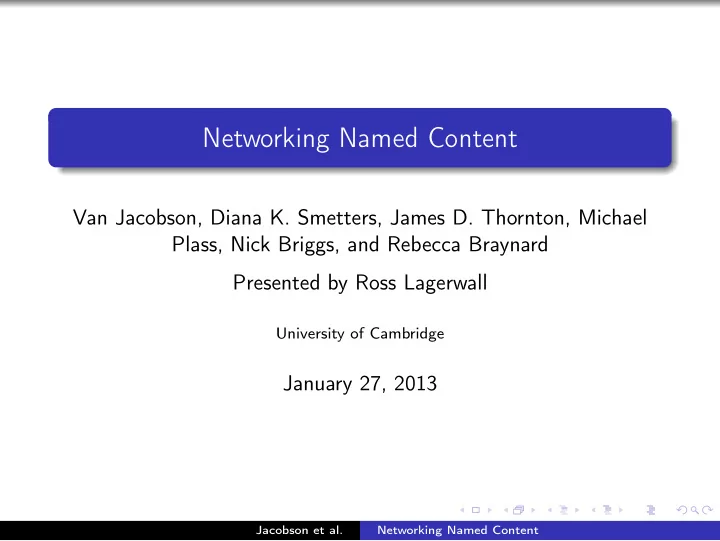

Networking Named Content Van Jacobson, Diana K. Smetters, James D. Thornton, Michael Plass, Nick Briggs, and Rebecca Braynard Presented by Ross Lagerwall University of Cambridge January 27, 2013 Jacobson et al. Networking Named Content
Background Networking is done host-to-host in a conversation fashion. But our internet usage doesn’t fit this pattern. We care about content, not location of the data. Jacobson et al. Networking Named Content
Previous Work Research has tried to use content as a first class citizen rather than location. Previous work has used flat opaque names to data. These names are then mapped to user friendly ones. TRIAD uses structured, user friendly names with a modified DNS server. Jacobson et al. Networking Named Content
Solution CCN tries to solve the problem by using user friendly names which describe content. Routing is done on content rather than host location. CCN defines Interest and Data packets. To retrieve data, a node broadcasts an Interest. Jacobson et al. Networking Named Content
Solution Jacobson et al. Networking Named Content
Solution Jacobson et al. Networking Named Content
Solution On receiving an Interest: reply with data reply with cached data store a breadcrumb in the pending interest table and forward it Jacobson et al. Networking Named Content
Solution Data follows the breadcrumbs back. Breadcrumbs are replaced with a cached copy of the packet. Interests can be pipelined similar to TCP’s window. Sequencing is achieved by altering the structured name. A limited form of querying is available with primitives such as RightMostChild. Jacobson et al. Networking Named Content
Strategy The strategy layer is responsible for reliability. It uses timeouts to resend interests. The sender of data is stateless. The strategy layer can also use multiple faces with a policy such UsageBasedCharging or PeakUseLimited . Sender will only deliver data once. CCN can work with IP’s routing scheme. Jacobson et al. Networking Named Content
Security Protection and trust are part of the content, not the connection. Content packets are signed which binds the name, key and content giving integrity, pertinence and provenance. Keys are retrieved as content which allows arbitrary trust models to be developed. Example: hierarchical or peer-to-peer. Jacobson et al. Networking Named Content
Evaluation Implemented as userspace daemon and client library. For testing, CCN packets are encapsulated in UDP. Jacobson et al. Networking Named Content
Evaluation Jacobson et al. Networking Named Content
Evaluation Jacobson et al. Networking Named Content
Opinion The paper is overly ambitious. It tries to replace: IP TCP and UDP HTTPS and other application layer protocols PKI Jacobson et al. Networking Named Content
Opinion Provides a good solution to the original problem. It seems to match up with HTTP GET requests for static data. It does not seem like a complete replacement for the TCP/IP network stack. What about SSH, VPNs, pushing data with online backup, gaming, etc? Jacobson et al. Networking Named Content
Opinion What about unwanted caching? What happens to all the application layer protocols? What about broadcasting in a large busy LAN? How does application demultiplexing work? How does caching work with dynamically generated content? Jacobson et al. Networking Named Content
Recommend
More recommend